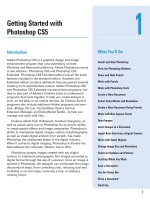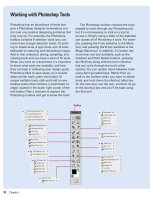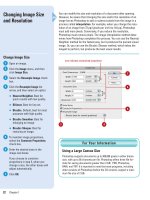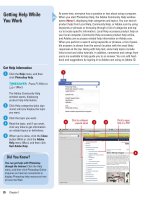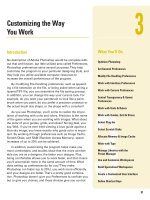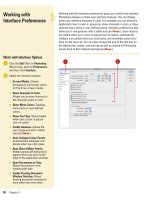Photoshop cs5 by steve Johnson part 1 potx
Bạn đang xem bản rút gọn của tài liệu. Xem và tải ngay bản đầy đủ của tài liệu tại đây (920.31 KB, 9 trang )
ptg
Getting Started with
Photoshop CS5
Introduction
Adobe Photoshop CS5 is a graphics design and image
enhancement program that runs seamlessly on both
Windows and Macintosh platforms. Adobe Photoshop comes
in two editions: Photoshop CS5 and Photoshop CS5
Extended. Photoshop CS5 Extended edition has all the same
features included in the standard edition. However, the
Extended edition contains additional features geared towards
creating more sophisticated content. Adobe Photoshop CS5
and Photoshop CS5 Extended are stand-alone programs, but
they're also part of Adobe's Creative Suite of professional
programs that work together to help you create designs in
print, on the Web, or on mobile devices. All Creative Suite 5
programs also include additional Adobe programs and serv-
ices—Bridge, CS Live, ConnectNow, Device Central,
Extension Manager, and ExtendScript Toolkit—to help you
manage and work with files.
Creative artists from Hollywood, brochure designers, as
well as casual users turn to Photoshop for its proven ability
to create special effects and image composites. Photoshop's
ability to manipulate digital images, restore old photographs,
as well as create digital artwork from scratch, has made
Photoshop the undisputed leader in the digital industry.
When it comes to digital imaging, Photoshop is literally the
best software the computer industry has to offer.
Photoshop accepts images created with any digital
camera, or traditional photographic film images converted to
digital format through the use of a scanner. Once an image is
opened in Photoshop, the designer can manipulate the image
thousands of ways, from correcting color, reducing dust and
scratches in an old image, removing a tree, or adding a
missing friend.
1
1
What You’ll Do
Install and Start Photoshop
View the Photoshop Window
Show and Hide Panels
Work with Panels
Work with Photoshop Tools
Create a New Document
Select Color Modes and Resolution
Create a New Document Using Presets
Work with Non-Square Pixels
Open Images
Insert Images in a Document
Import Raw Data from a Digital Camera
Work with Smart Objects
Change Image Size and Resolution
Check for Updates and Patches
Get Help While You Work
Save a Document
Use the Status Bar
Close a Document
Finish Up
1
From the Library of Wow! eBook
From the Library of Michele Renth
ptg
2 Chapter 1
2
3
The process of installing the Photoshop application, either 32- or 64-bit
edition (New!), is fairly straightforward; you insert the Photoshop CS5
install disc into your DVD drive or download the software online to your
computer, double-click the setup program and simply follow the on-
screen instructions. The first thing that will happen is that the installer
will check to see if you have the minimum system requirements. If you
meet the minimums, the installer will guide you through the steps to
complete the installation. The whole process takes about ten minutes,
and at the end of the process you can launch Photoshop for the first
time. Remember to have your serial number handy, because you will
have to type it in during the installation process. It's a good idea to
have that serial number in a safe place, just in case you would need to
reinstall Photoshop.
Installing Photoshop
Install Photoshop CS5 in
Windows
Insert the Photoshop CS5 DVD into
your DVD ROM drive, or download
the software online to your hard
disk.
If necessary, double-click the DVD
icon or open the folder with the
downloaded software, and then
double-click the setup icon.
Follow the on-screen instructions
to install the product; the installer
asks you to read and accept a
licensing agreement, enter a serial
number, indicate the language you
want, enter or create an Adobe ID
or skip the step, and specify where
you want to install the software.
3
2
1
Did You Know?
The DVD comes with bonus content.
The Resources and Extras DVD
included with Adobe CS5 products
includes bonus content and files in the
Goodies folder. Check it out! For more
free online resources, go to
www.adobe.com
and visit Adobe
Studio Exchange.
From the Library of Wow! eBook
ptg
Chapter 1 Getting Started with Photoshop CS5 3
Install Photoshop CS5 in
Macintosh
Insert the Photoshop CS5 DVD into
your DVD ROM drive, or download
the software online to your hard
disk.
If necessary, double-click the DVD
icon or open the folder with the
downloaded software, and then
double-click the Install icon.
Follow the on-screen instructions
to install the product; the installer
asks you to read and accept a
licensing agreement, enter a serial
number, indicate the language you
want, enter or create an Adobe ID
or skip the step, and specify where
you want to install the software.
3
2
1
3
Did You Know?
Most Adobe applications can be
downloaded.
It's all very simple, you
go to
www.adobe.com
, click the
Products menu item, and then select
the application you want to purchase.
You will need a credit card (of course),
and a lot of bandwidth.
You can create a shortcut on the
Macintosh.
Drag and drop the
Photoshop program to the bottom of
the monitor screen, and then add it to
the shortcuts panel.
You can use a 32- or 64-bit version of
Photoshop.
The terms 32-bit and 64-bit
refer to the way a computer CPU
processes information. A 64-bit system
handles large amounts of RAM more
effectively than 32-bit systems. The 64-
bit version of Photoshop (New!) per-
forms day-to-day tasks 10% faster,
especially when you work with very
large files.
Hardware/Software Minimum (Recommended)
WINDOWS
Computer Processor Intel Xeon, Xeon Dual, Centrino, or Pentium 4;
AMD compatible
Operating System Microsoft Windows XP SP3 or Windows
Vista SP1 or Windows 7
Hard Drive 1 GB of available space
Available RAM 1 GB (2 GB recommended)
Video Card 16-bit; 256 MB Video RAM
Monitor Resolution 1024 x 768 (1280 x 800 recommended)
DVD-ROM drive Any type
MACINTOSH
Computer Processor Intel-based Macs
Operating System Macintosh OS X 10.5.7 or higher
Hard Drive 2 GB of available space
Available RAM 1 GB (2 GB recommended)
Video Card 16-bit; 256 MB Video RAM
Monitor Resolution 1024 x 768 (1280 x 800 recommended)
DVD-ROM drive Any type
Photoshop CS5 System Requirements
From the Library of Wow! eBook
ptg
4 Chapter 1
You can launch Photoshop like any other program. After you launch
Photoshop, the program checks for updates to Photoshop and related
CS5 software—including Adobe Bridge, and Adobe Help Viewer—
using the Adobe Updater. If you want to access the Adobe Updater at
any time, you can choose Updates from the Help menu. Once inside
this dialog box, you can click on Preferences to set Adobe Updater
Preferences options. You can choose to check for updates weekly or
monthly and you can also specify whether you want Adobe to automat-
ically download updates or ask before performing the download. See
"Checking for Updates and Patches" on page 24 for information on
using the Adobe Updater Preferences dialog box.
Starting Photoshop
Start Photoshop CS5 in
Windows
Click Start on the taskbar.
Point to All Programs (which
changes to Back).
Point to an Adobe Collection CS5
menu, if needed.
Click Adobe Photoshop CS5.
If you’re starting Photoshop CS5
for the first time, you might be
prompted to specify the following:
◆ Enter or create an Adobe ID to
register the product, click
Submit, and then click Done.
5
4
3
2
1
Did You Know?
You can create and use a shortcut
icon on your desktop to start
Photoshop (Win).
Click Start on the
taskbar, point to All Programs, right-
click Adobe Photoshop CS5, point to
Send To, and then click Desktop
(Create Shortcut). Double-click the
shortcut icon on your desktop to start
Photoshop.
1
2 4
From the Library of Wow! eBook
ptg
Chapter 1 Getting Started with Photoshop CS5 5
Start Photoshop CS5 in
Macintosh
Open the Applications folder
(located on the main hard drive).
Double-click the Adobe Photoshop
CS5 folder.
Double-click the Adobe Photoshop
CS5 program icon.
If you’re starting Photoshop CS5
for the first time, you might be
prompted to specify the following:
◆ Enter or create an Adobe ID to
register the product, click
Submit, and then click Done.
4
3
2
1
Shortcut for Adobe Photoshop CS5
3
Did You Know?
You can create a shortcut on the
Macintosh.
Drag and drop the
Photoshop application to the bottom of
the monitor screen, and then add it to
the dock.
You can create and use a keyboard
shortcut to start Photoshop (Win).
Click
Start on the taskbar, point to All
Programs, right-click Adobe Photoshop
CS5, and then click Properties. In the
Shortcut Key box, type or press any
letter, number, or function key, such as
P, t o w h i c h W i n d o w s a d d s C t r l + A l t .
Click OK to create the keyboard short-
cut. From anywhere in Windows, press
the keyboard shortcut you defined
(Ctrl+Alt+P) to start Photoshop.
From the Library of Wow! eBook
ptg
6 Chapter 1
Viewing the Photoshop Window
Options bar
Displays options for the
active tool.
Panels
Gives you
access to
Photoshop’s
panels.
Document Window
Displays the current image, or it can be used
to create a graphic image from scratch.
Tool box
Gives you
access to
all of the
drawing,
painting, and
selection
tools.
Zoom Size
Lets you quickly select a view
size for the active document.
Applications bar
Displays options for working with
and switching between documents
and applications.
Workspace menu
Switches between
workspaces.
From the Library of Wow! eBook
ptg
Panels on Window menu
1
Chapter 1 Getting Started with Photoshop CS5 7
Panels give you easy access to many task-specific commands and
operations from color control to vector path information. By default, the
main panel display is located along the right side of your window. You
can use the Window menu or click a panel tab within a group to display
it, and then select options on the panel or choose panel-specific
commands from the Panel Options menu to perform actions. Instead of
continually moving, resizing, or opening and closing windows, you can
use the header bar with the panel tabs to collapse or expand individual
panels within a window to save space.
Showing and Hiding
Panels
Open and Close a Panel
Click the Window menu.
Click a panel name, such as Color,
Layers, Navigator, Options, or
Tool s.
TIMESAVER
To cl os e a pa nel,
or a single tab, click the Options
menu and then click Close Tab
Group or Close (for a single tab).
On the Mac, you can also click the
Close button on the panel.
Collapse or Expand a Panel
To co llapse or exp and an ope n
panel, click the dark gray area or
double-click a title tab on the
header bar of the panel.
If the panel is in icon mode, click
on the icon to expand or collapse
it. To reduce the panel back to
icon mode, click on the double
right-facing arrows in the dark
gray area. To expand from icons to
panels, click on the double left
facing arrows.
1
2
1
Collapsed panels
Expanded panels
1
From the Library of Wow! eBook
ptg
8 Chapter 1
Working with
Panels
Add a Panel
Select a panel by clicking on the
named panel, or click the Window
menu, and then click the panel
name you want to display.
Drag the panel into another
group.
Subtract a Panel
Select a panel by clicking on the
named panel or click the Window
menu, and then click the panel
name you want to display.
Drag the panel out of the group.
Drop it onto the desktop (Mac) or
Photoshop window (Win).
3
2
1
2
1
The movable panels are organized into groups, such as Color/
Swatches/Styles and History/Actions, to save screen space and help
with workflow. You can also add or subtract specific panels within a
group to customize your workspace. A panel appears with a header,
which includes the tab titles and three options: the Collapse to Icons
button, the Close button, and an Options menu. The Options menu pro-
vides you with panel commands. The entire set of panels includes a
double arrow at the top you can use to collapse and expand the entire
panel back and forth between icons and full panels.
2
1
A group with two panels:
Color and Swatches
1
Click to choose commands
from the panel menu
2
Did You Know?
You can dock and undock panels.
You
can dock and undock, or temporarily
attach and detach, panels or panel
groups in docking channels. A docking
channel is a region located on the left
and right side of the Photoshop win-
dow to which you can temporarily
attach and detach panels. When you
drag a panel over a dockable area, a
blue line or outline appears.
Hiding Panels While You Work
If Photoshop's panels get in the way, just press the Tab key to tem-
porarily hide all the panels. Or, you can hold down the Shift key, and
then press the Tab key to hide the panels, but leave the Toolbox and
Options bar. Press the Tab key again to restore all the panels to their
most recent positions.
For Your Information
From the Library of Wow! eBook
ptg
Chapter 1 Getting Started with Photoshop CS5 9
Collapse and Expand the Panel
Set Between Icons and Panels
◆ To co llapse the pa nel set to icons
with text, click the double arrow
pointing right (Collapse to Icons) at
the top of the panels.
◆ To ex pand th e panel se t from icons
with text to full panels, click the
double arrow pointing left (Expand
Panels) at the top of the panels.
◆ To ha ve an expan de d pa nel ic on
automatically collapse or hide
when you click away, right-click
(Win) or Control-click (Mac) a
panel, and then click Auto-
Collapse Icon Panels or Auto-
Show Hidden Panels.
Use the Panel Options Menu
Open or expand a panel.
Click the Options button on the
right side of the panel header bar.
Click a command from the list
(commands vary). Common
commands include:
◆ Close. Closes the currently
displayed tab in the panel.
◆ Close Tab Group. Closes all the
tabs in the panel.
3
2
1
3
2
Click to collapse the
panel set
1
Click to expand
the panel set
From the Library of Wow! eBook
